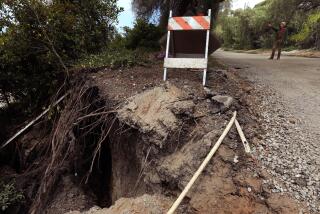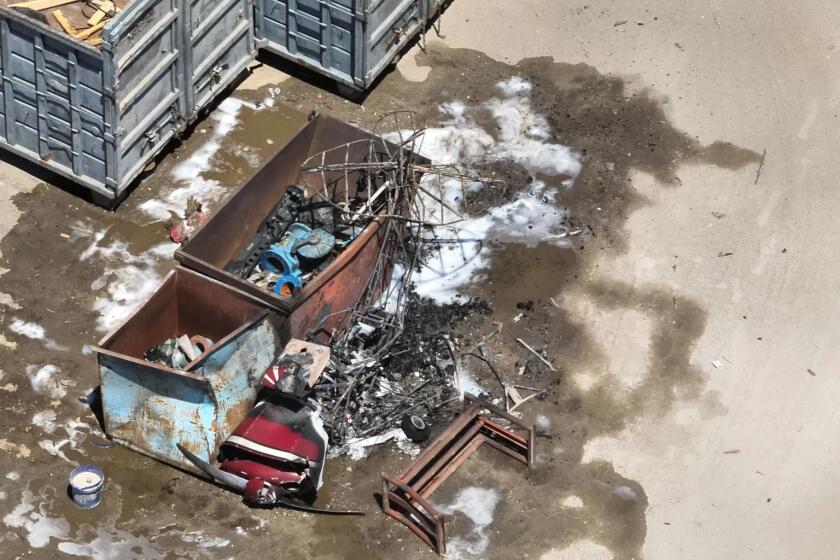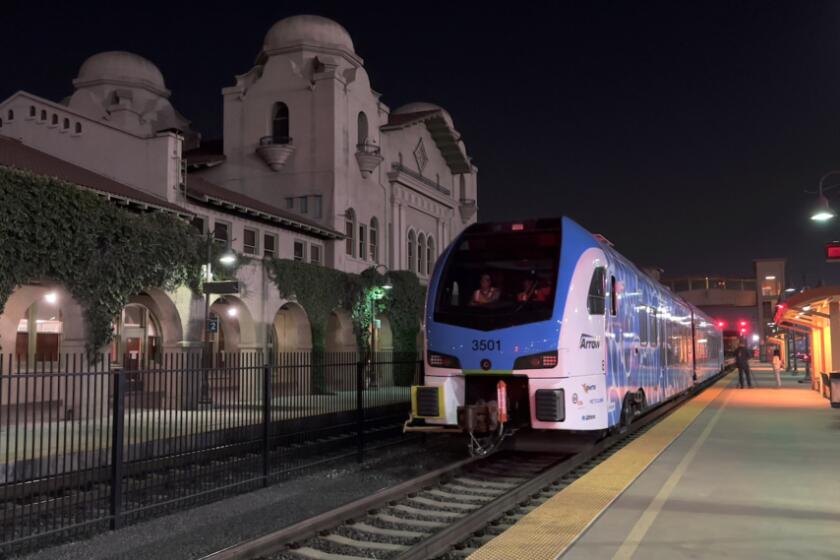Fast Freight : Alameda Street Expressway Proposed From Downtown to Ports
Alameda Street, which follows the rutted route once used by Spanish oxcarts hauling cargo from the Los Angeles pueblo to San Pedro Harbor, will be transformed into a $502-million consolidated rail and truck expressway, if all goes according to plan.
Final plans for the 20-mile freight expressway--called the Alameda Corridor--are being drafted by engineers. Congress is being lobbied to approve $332 million toward the project. That is the project’s biggest hurdle. The state has committed $80 million to develop the corridor and the remainder of funds would come from Los Angeles County and various cities and railroads involved, officials said.
“The Alameda Corridor will . . . consolidate truck and rail traffic on one six-lane highway,” said Los Angeles City Councilwoman Joan Milke Flores, who chairs the Alameda Corridor Transportation Authority board of directors. The trains would run along the highway median, possibly operating below street level in a 30-foot trench.
The corridor authority, which must approve the final plans, was formed by a joint agreement among the Long Beach and Los Angeles port authorities, the city and county of Los Angeles, and five smaller cities along the corridor--Vernon, Huntington Park, South Gate, Lynwood and Carson.
Completion of the corridor will “remove a large amount of truck traffic from city streets (and freeways), improve air quality in the L.A. Basin and take trains off of busy intersections along the way,” Flores said.
Because it follows the most direct route to the ports, Alameda Street over the years has evolved into a major rail and truck artery. Today, the street is a rutted, heavily traveled maze of big trucks, slow freight trains--running down the center line--and lost motorists trying to find the nearest freeway.
In 1984, when harbor officials announced plans to expand the two ports, it became obvious that the increased flow of freight moving on and off the docks would have a major impact on already congested rail, freeway and surface street traffic.
The two-port complex in San Pedro Bay is the busiest harbor in the United States. When the $4.8-billion expansion is completed in 2020, the amount of cargo handled will at least double, according to Gilbert V. Hicks, executive director of the corridor authority.
The ports now generate 19,000 truck trips daily and involve 25 trains in moving freight. Hicks said these numbers will go up to 49,000 truck trips and 90 trains a day sometime after the turn of the century.
“We are concerned about traffic congestion, delays at grade crossings (and) noise pollution in residential areas,” Hicks said.
The answer, according to Hicks, is to widen Alameda to six lanes, three in each direction. Under preliminary plans, one express lane would be restricted to trucks, with two lanes for other vehicles. The consolidated railway would carry up to 100 freight trains a day, planners say. The plan calls for overpasses at 16 or more major streets to lift surface traffic over the corridor.
The project has no completion date yet, but several relatively small federal demonstration grants have been approved to get the project started, Hicks said. The federal money will pay to widen the southern end of Alameda and build three overpasses. These projects will cost $67 million and work could begin late this year or early next, he said.
The Alameda Corridor concept--highly praised by Los Angeles officials--has been grudgingly accepted by the smaller cities along the route.
Officials from Vernon to Carson complain that at least 20 long northbound and southbound freights pass through their central business districts every day, backing up east-west traffic on the streets and making it impossible at times for police and fire trucks to respond to emergency calls.
“When we first heard about the port expansion we were shocked at the projected number of trains,” said John Johnson, director of Compton community development. At first, Compton opposed the Alameda Corridor because it would cut the city in half, but Johnson said the alternatives were worse.
“So now the city is going along with the plan, provided we get the grade separations and something is done about noise pollution,” he said. Compton has received one of the federal demonstration grants to help fund a $7-million overpass at Rosecrans Avenue.
Huntington Park has taken the lead in insisting that the corridor’s train tracks be depressed in a 30-foot trench to diminish the impact on the city center. “The (train) corridor passing through Huntington Park must be depressed,” said Mayor Tom Jackson.
Corridor plans call for the consolidation of all freight traffic that now moves on the four rail lines that connect the harbor to big rail yards in downtown Los Angeles. All trains would use the same corridor tracks. To do this, three railroad companies--Southern Pacific, Union Pacific and Santa Fe--must negotiate a joint operating agreement.
The right of way for the corridor line is owned by Southern Pacific Transportation Co. Negotiations on an agreement are under way, Hicks said. While he was optimistic that an agreement could be reached, he said the authority is also exploring acquiring the right of way itself.
The thousands of trucks, in addition to traveling on Alameda, also add to congestion on the Harbor or Long Beach freeways.
To streamline their operations and help ease the congestion caused by trucks, the ports are spending an additional $297 million to link the harbor’s roads and rail lines to the corridor. In the process, they will develop more dockside rail sidings so that containers can be unloaded directly onto rail cars. This will reduce the dependence on truck traffic, port officials said.
“We should take some truck traffic off of (the Harbor and Long Beach freeways) by putting the (containers) on the trains,” said Geraldine Knatz, director of planning for the Port of Long Beach. Even so, port expansion will more than double, she said. Much of the increased traffic can be directed down the corridor, she said.
THE ALAMEDA CORRIDOR
The proposed $502-million, 20-mile-long Alameda Corridor project will speed freight traffic from the ports into downtown Los Angeles. The project is also expected to reduce truck traffic on the Long Beach and Harbor freeways significantly. Work on parts of the project will start this year. The project will use federal, state and local funds, although major funding has yet to be authorized by Congress, officials said.
The Alameda Corridor Transportation Authority will build rail and truck expressways along Alameda Street. The plan envisions the rail lines operating from within a 30-foot-deep trench along Alameda Street that will eliminate most rail crossings at street level. The truck expressways will run north and south, one on each side of the sunken railway.
More to Read
Sign up for Essential California
The most important California stories and recommendations in your inbox every morning.
You may occasionally receive promotional content from the Los Angeles Times.






